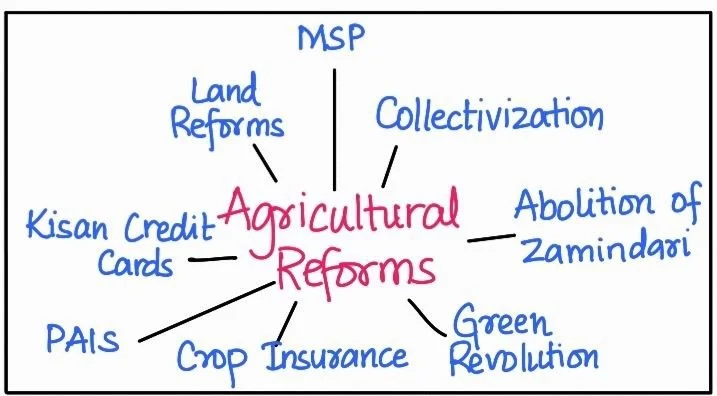![]() December 9, 2023
December 9, 2023
![]() 656
656
![]() 0
0
Agricultural development in India aims to increase farm production to meet rising population demands. It involves expanding cropped areas, crop diversity, irrigation, fertilizers, and mechanization.
Agriculture has developed at different places in different parts of the world. Developing countries with large populations usually practice intensive agriculture where crops are grown on small holdings mostly for subsistence
|
For better understanding of the nature of farming in India, consider the following two examples which compare farming activities of the average farmer in India and USA. A Farm in India Small farmer Munna lal in Uttar Pradesh owns 1.5-hectare farmland with fertile soil, utilizes high-yielding seeds with advice of experts and grows wheat, rice, and pulses in his farms and sells them in nearby markets. He rents a tractor for plowing, irrigates from a nearby tubewell. His whole family is involved in farming. He also raises buffaloes and hens and sells milk and is also a member of a cooperative society. A Farm in USA
An agricultural field in India and a farm in USA. The average size of a farm in the USA is much larger than that of an Indian farm. A typical farm size in the USA is about 250 hectares. A farmer named Joe owns a land of 300 hectares in Lowa. He focuses on crops like corn, soybean, wheat, cotton, and sugarbeet, practices precision farming with soil testing and use of technology. Further, he performs mechanized operations with tractors and modern equipment, utilizes chemical fertilizers and pesticides, uses automated grain storage and marketing. Thus Joe operates his farm as a business. |
|---|
Harvesting Progress: Advancements in Agricultural Output and Technology in India
Indian agriculture is adversely affected by various issues impacting development of agriculture in India and livelihood of farmers.
| National Mission for Sustainable Agriculture(NMSA):
NMSA is an initiative to make agriculture more productive, sustainable, remunerative and climate resilient by promoting location specific integrated/composite farming systems and to conserve natural resources through appropriate soil and moisture conservation measures. The Government has been promoting organic farming in the country through schemes such as Paramparagat Krishi Vikas Yojana (PKVY) and Rashtriya Vikas Yojana (RKVY). |
Tacking all these issues will surely contribute to development of agriculture in India.
To address the above problems comprehensively, various technological and Institutional measures has been initiated by the government.
|
Bhoodan and Gramdan Vinoba Bhave, a spiritual heir of Mahatma Gandhi, launched the Bhoodan movement in India. He started this movement from Pochampalli in Andhra Pradesh after some poor landless villagers demanded some land for their economic well-being. As a beginning, Shri Ram Chandra Reddy offered 80 acres of land to be distributed among 80 land-less villagers. This act was known as ‘Bhoodan’. Later he traveled and introduced his ideas widely all over India. Some zamindars, owners of many villages, offered to distribute some villages among the landless. It was known as Gramdan. However, many land-owners chose to provide some part of their land to the poor farmers due to the fear of land ceiling act. This Bhoodan-Gramdan movement initiated by Vinoba Bhave is also known as the Blood-less Revolution. |
|---|

|
Farmer’s Portal of India: The Farmer’s Portal is a platform for farmers to seek any information related to agriculture. Detailed information on farmers’ insurance, agriculture storage, crops, extension activities, seeds, pesticides, farm machineries, etc. is provided. Details of fertilizers, market prices, package and practices, programmes, welfare schemes are also given. Block level details related to soil fertility, storage, insurance, training, etc. are available in an interactive map. Users can also download farm friendly handbooks, scheme guidelines, etc. |
|---|
|
Glossary
|
|---|
Also Read: Diverse Types of Agriculture: Understanding Forms and Practices Worldwide
<div class="new-fform">
</div>

Latest Comments